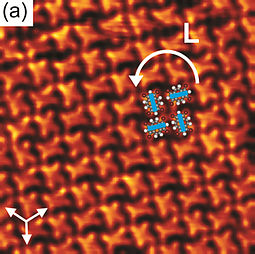
Back تجميع ذاتي Arabic 4D çap texnologiyaları AZ Self-assembly Czech Selvsamling Danish Selbstassemblierung German Autoensamblaje Spanish خودسامانی FA Auto-assemblage French הרכבה עצמית HE स्व-एकत्रण HI



Self-assembly is a process in which a disordered system of pre-existing components forms an organized structure or pattern as a consequence of specific, local interactions among the components themselves, without external direction. When the constitutive components are molecules, the process is termed molecular self-assembly.

Self-assembly can be classified as either static or dynamic. In static self-assembly, the ordered state forms as a system approaches equilibrium, reducing its free energy. However, in dynamic self-assembly, patterns of pre-existing components organized by specific local interactions are not commonly described as "self-assembled" by scientists in the associated disciplines. These structures are better described as "self-organized", although these terms are often used interchangeably.
- ^ a b Wetterskog E, Agthe M, Mayence A, Grins J, Wang D, Rana S, et al. (October 2014). "Precise control over shape and size of iron oxide nanocrystals suitable for assembly into ordered particle arrays". Science and Technology of Advanced Materials. 15 (5): 055010. Bibcode:2014STAdM..15e5010W. doi:10.1088/1468-6996/15/5/055010. PMC 5099683. PMID 27877722.
- ^ Pham TA, Song F, Nguyen MT, Stöhr M (November 2014). "Self-assembly of pyrene derivatives on Au(111): substituent effects on intermolecular interactions". Chemical Communications. 50 (91): 14089–92. doi:10.1039/C4CC02753A. PMID 24905327.
- ^ Kling F (2016). Diffusion and structure formation of molecules on calcite(104) (PhD). Johannes Gutenberg University Mainz. doi:10.25358/openscience-2179.

